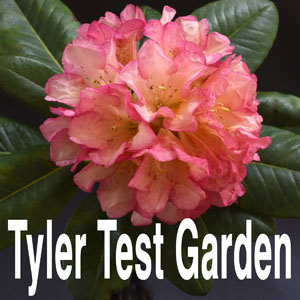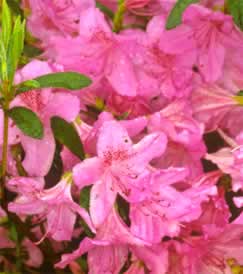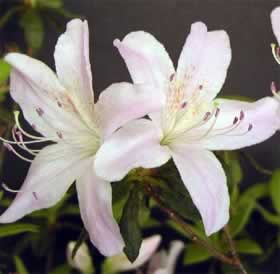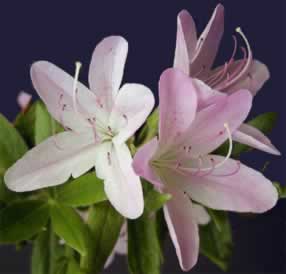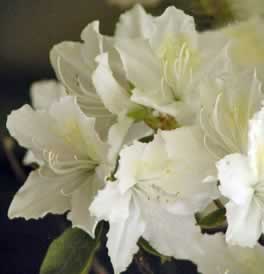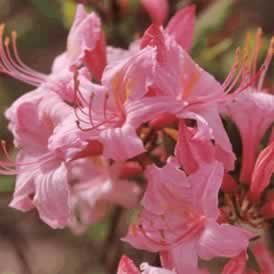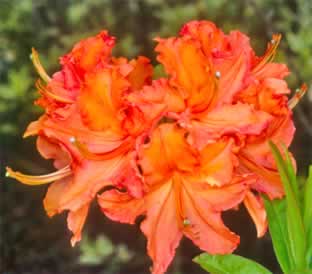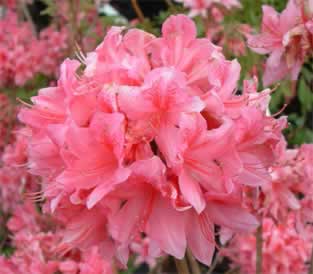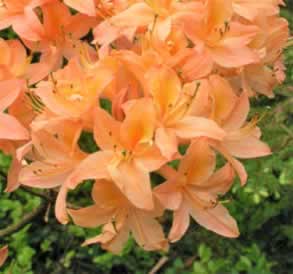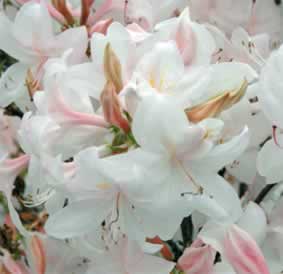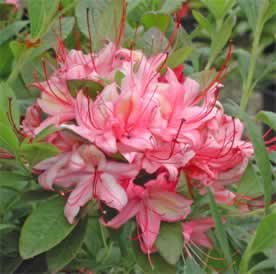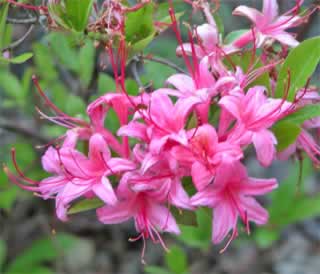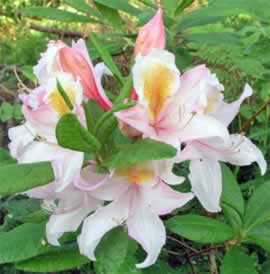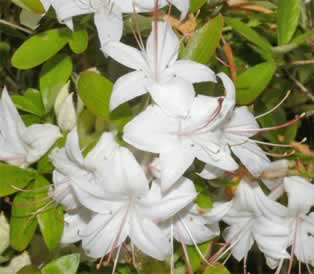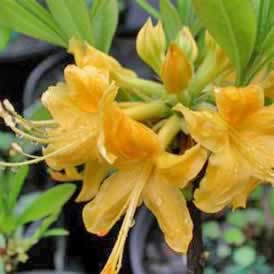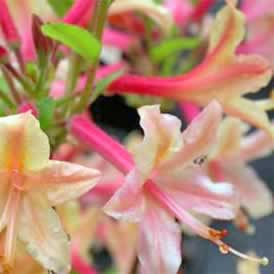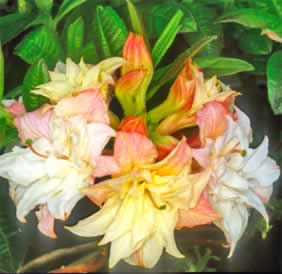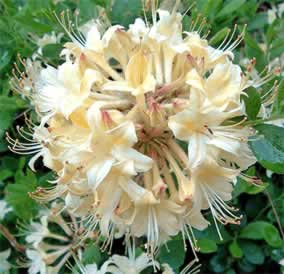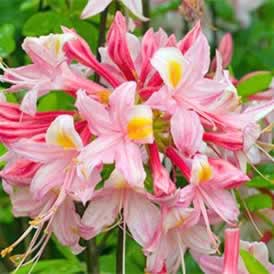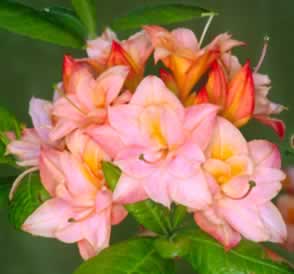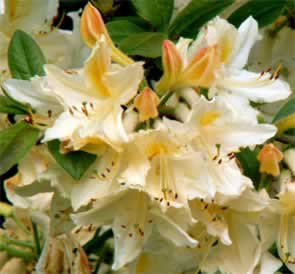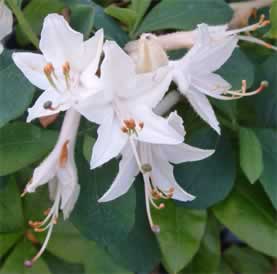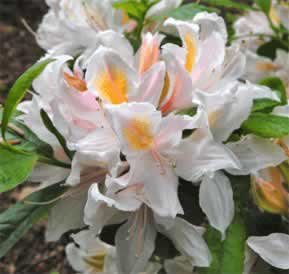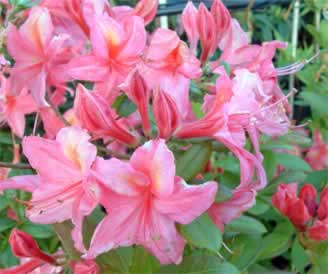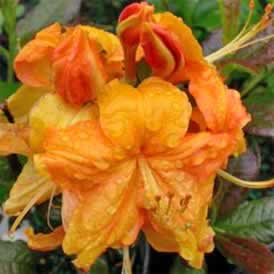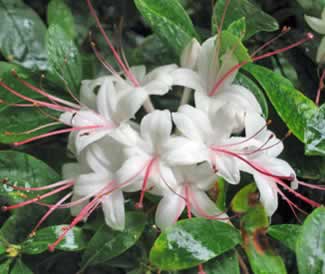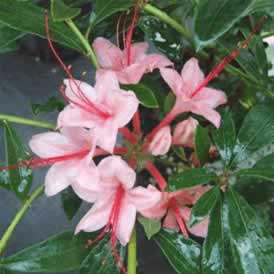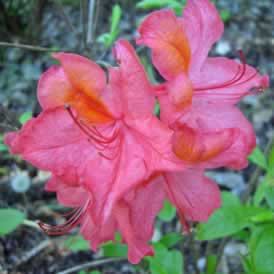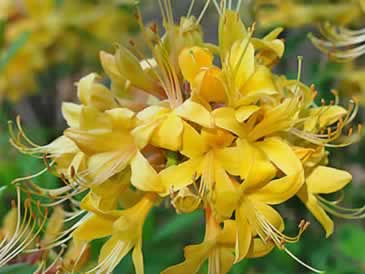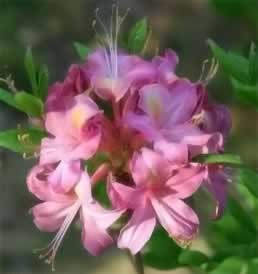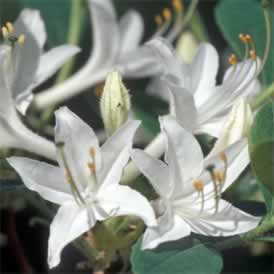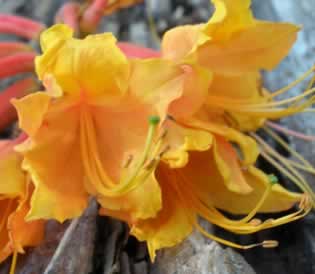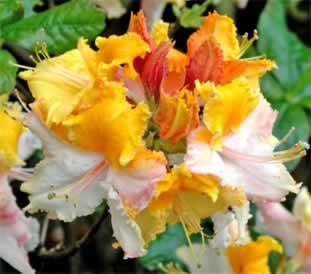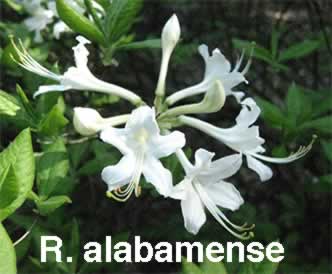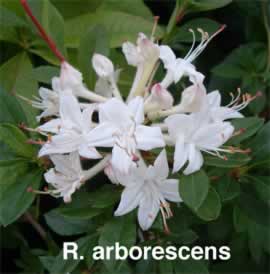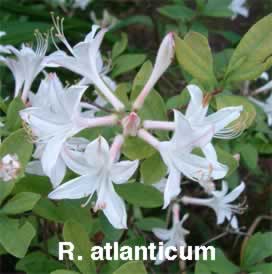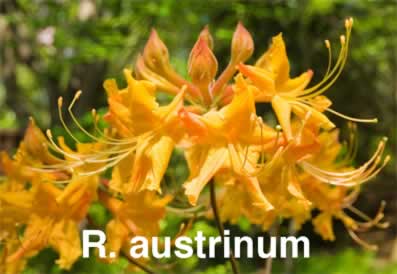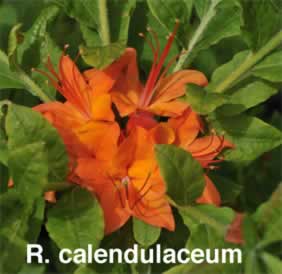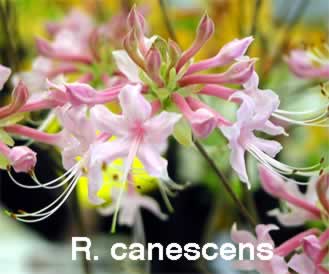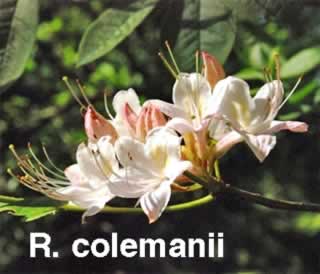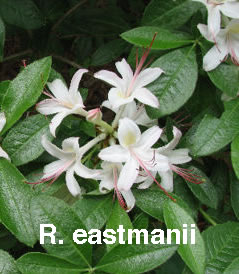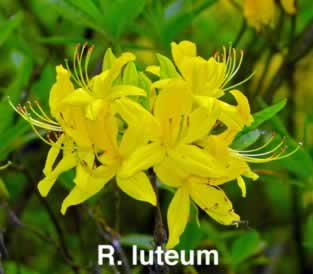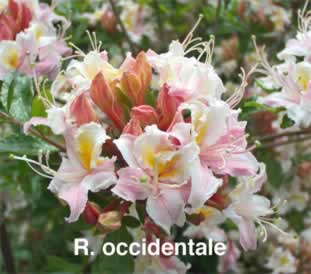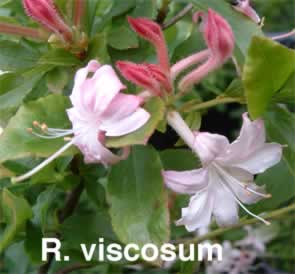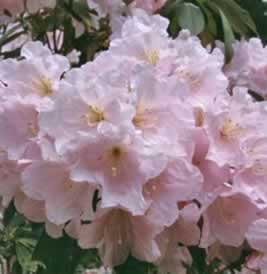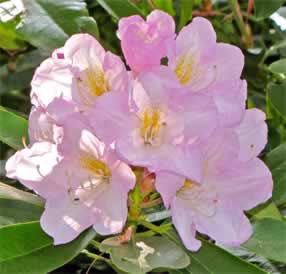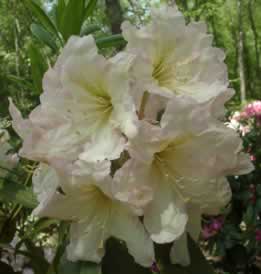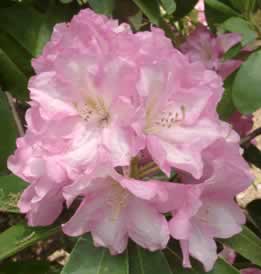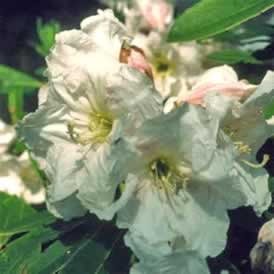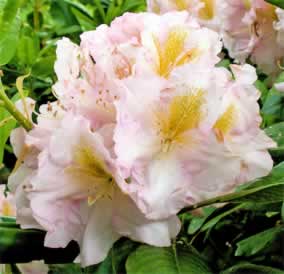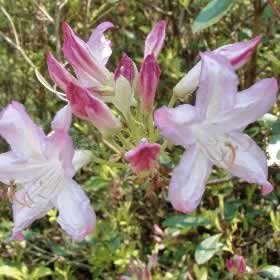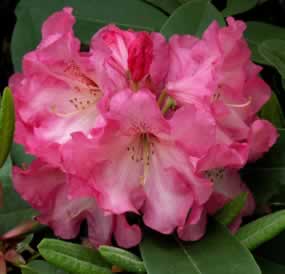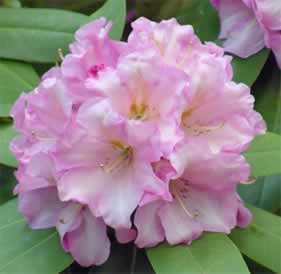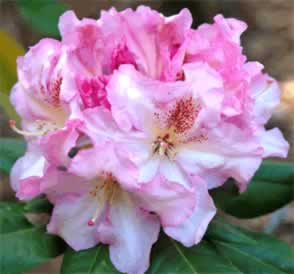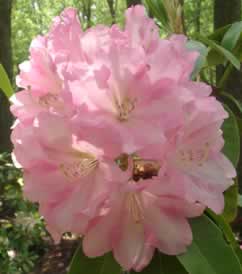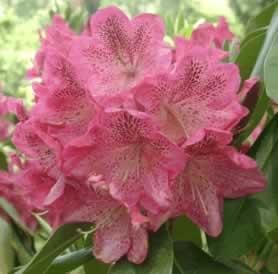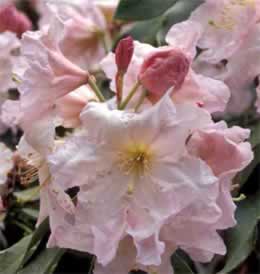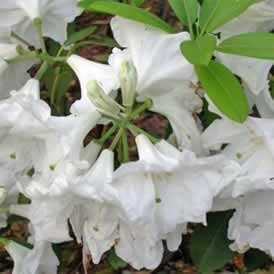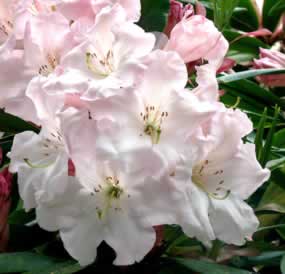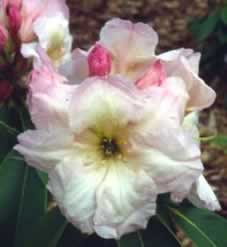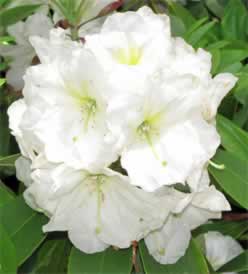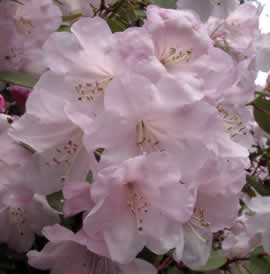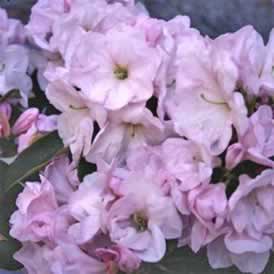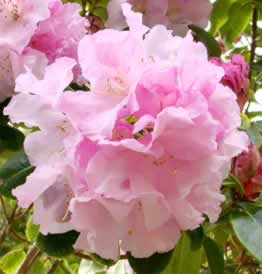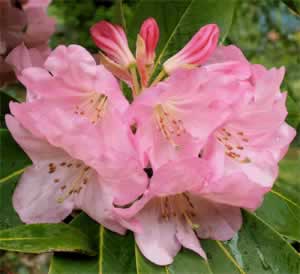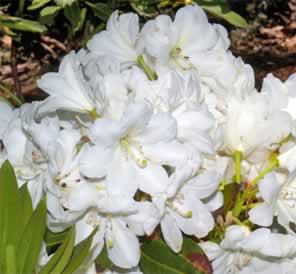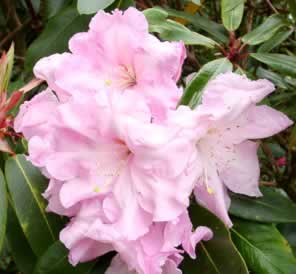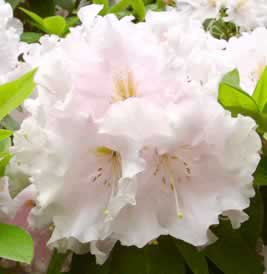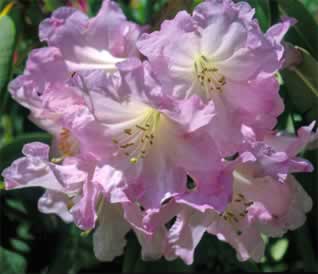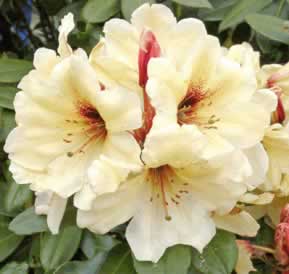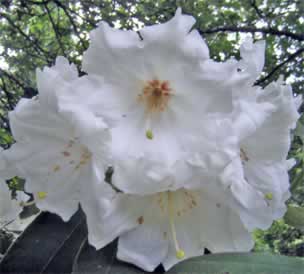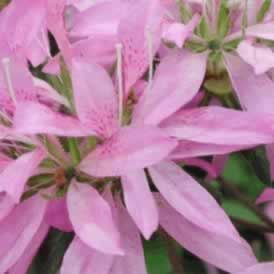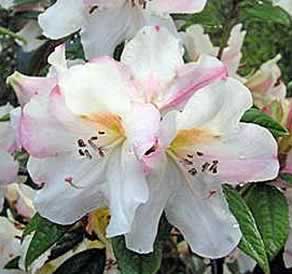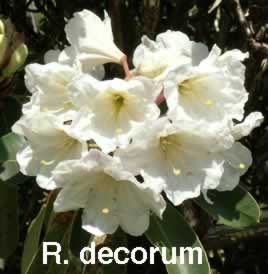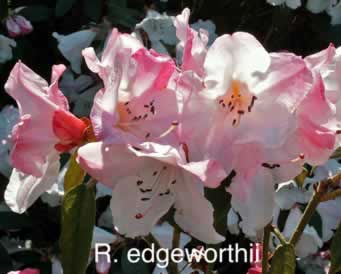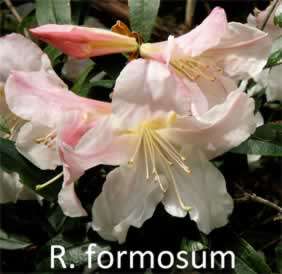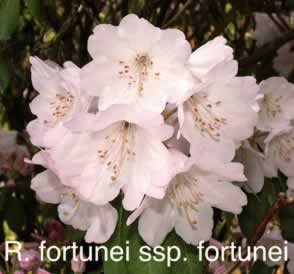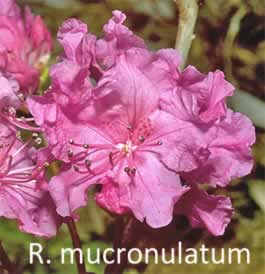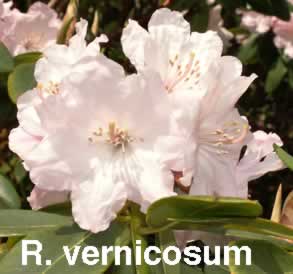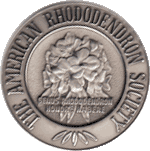R. stenopetalum 'Macrosepalum' is the only "evergreen" azalea species reported to be moderately or highly fragrant. It is actually deciduous, but it is classified in Subgenus Azaleastrum, which is the group with all of the evergreen azalea species. Other evergreen azaleas are sometimes semi-deciduous or deciduous, especially in certain environments. R. stenopetalum 'Macrosepalum' (spider azalea) – 3', +5F. This is an unusual species. It is normally 4-foot-tall shrub with narrow, ribbon-like evergreen leaves, 3 inches long and 1/2 inch wide, and rose-pink flowers with deeply divided petals. The variety 'Linearifolium' (formerly R. macrosepalum 'Linearifolium' or R. linearifolium) is somewhat smaller, 3 feet tall, and the leaves are deciduous and 3 inches long. But the flowers are even more curiously shaped than those of the species; they have 1 1/4-inch-long sepals that overshadow the petals. The flowers of this variety are fragrant and have been bred in several colors; in one, 'Polypetalum', flower petals and leaves are so similar in size that the plant seems to have pink and green leaves. Although the fragrant lepidote rhododendron R. mucronulatum is not an azalea, it is often bred with evergreen azaleas to form fragrant hybrid evergreen azaleas. R. mucronulatum is a rhododendron that resembles an azalea and is often found on lists of deciduous azaleas. August to Frost — (Beaudry) -5F, 3'. A repeat bloomer, 'August to Frost' is plant hardy to Zone 6b. Large white flowers cover a compact and spreading plant. The name is an apt description of this azalea's behavior. Unlike most azaleas, it blooms on new growth in August and continues into the fall. Corsage — (Gable) -5F, 6'. A prolific bloomer with pale lavender purple blooms that will get 2½'' across on a plant that needs room, as it will get as wide at tall. Lovely fragrance with age. Frostburg — (Yates) -10F, 3'. Flower 3" across, hose-in-hose, fragrant, yellowish-white, with a light yellowish-green spotted blotch. Leaves oblanceolate, 2" long, dark green. [Return to Index] More Fragrant Evergreen Azaleas
I Get Misty — (Carlson) -10F, 4'. A faint blush of lavender pink on all petals with gold-maroon speckling in the throat – fragrant – a subtle stripe down the center of each petal. Koromo Shikibu — (R. stenopetalum 'Linearifolium' hybrid) -15F, 3'. This spreader is distinguished by its light green, hairy leaves that take on a red tinge in winter. Fragrant flowers are lavender with rose-violet flecks and dark tips. Formerly called macrosepalum, its strap-like petals, measuring ½'' in width and 1½'' in length, provide a nice contrast to the broader lobed flowers of most azaleas. Star Scent — (Carlson) -10F, 4'. An especially fragrant soft lavender pink. Whitney's White — (Whitney) 0F, 3'. Nicely scented, single white flowers with frilled petals and a subtle chartreuse-yellow flare on a particularly hardy upright growing plant. [Return to Index] Fragrant Hybrid Deciduous Azaleas
Northern Lights Fragrant Deciduous Azalea Species
Weston Fragrant Deciduous Azaleas
Northern Lights fragrant deciduous azaleas:
Northern Lights fragrant deciduous azaleas include:Candy Lights (Northern Lights) – 5', -25F. Dome-shaped trusses in mid to late spring. Each holds 8-10 extremely fragrant light pink flowers streaked with pale yellow. Very hardy, disease resistant and a moderate growth rate in full sun to partial shade in well-drained soil. Nice purple fall color. Golden Lights Azalea (Northern Lights) – 4', -30. This fragrant yellow azalea glows as it perfumes the garden when in bloom. Lemon Lights (Northern Lights). – 5', -35F. This fine introduction features an abundance of lush, lemon-yellow flowers. Though a little less vigorous than other Northern Lights cultivars, the color and perfume make it a very worthwhile selection. It is powdery mildew resistant. [Return to Index] More Northern Lights fragrant deciduous azaleas:
Mandarin Lights (Northern Lights). – 6', -35F. The ball trusses of 'Mandarin Lights' are loaded with ruffled red-orange blossoms sporting a darker orange vein. A strong orange blotch on the upper lobe intensifies the fire. Blossoms appear in late May or early June on this upright, mounding plant. It is powdery mildew resistant. Fragrant. Rosy Lights Azalea (Northern Lights). – 4', -40F. Dark rosy pink blossoms completely cover this grand azalea. It's hardy to -40F and no matter how cool the weather, this beauty will always come through with a tremendous display in the spring. Fragrant. Spicy Lights Azalea (Northern Lights). – 3', -35F. The flower has a salmon color with a slight fragrance. Flower bud hardiness is rated at -35 degrees F. Plant *height is about six feet and spread is about eight feet. Fragrant. White Lights Azalea (Northern Lights). – 4', -50F. This plant can be grown practically anywhere! Not only is the plant hardy to -50F, but also the bud is hardy to -55F. It's fragrant too. The flower is white with a slender band of gold running up the center petal. [Return to Index] Weston fragrant deciduous azaleas include:
Lollipop - (Weston) 4', -20F. This lovely azalea has a distinctive fragrant pink bloom with a daring yellow flare that turns an attractive silvery pink as it ages. Millennium - (Weston) 4', -5F. The dusty-red flowers set against blue green foliage blend in the landscape. It's very late flowering and powdery mildew resistant. Fragrant. Parade - (Weston, cumberlandense x viscosum) 6', -25F. Deep pink, 1.5" trumpet blooms on this robust plant open in July, emitting a soft, sweet fragrance. Very hardy and very tall. It can reach heights of up to 8'. It is powdery mildew resistant Pink and Sweet - (Weston) 4', -20F. A very hardy, semidouble selection that has fragrant, purple-pink flowers with a golden flare in the throat. It blooms in June-July. Weston fragrant deciduous azaleas include:
Weston's Innocence - (Weston) 3', -25F. A spectacular hybrid that blooms in mid to late June. The strongly fragrant white flowers are abundant. A vigorously growing wide plant with upright branches, it is compact and becomes mound shaped with age. The glossy leaves are resistant to powdery mildew and have a deep red fall color. Takes full sun. Weston's Lemon Drop - (Weston) 3', -35F. Syn. 'Lemon Drop'. A summer flowering deciduous Azalea. Soft pink buds open to fragrant, yellow blossoms in July. Glossy green leaves turn a dark, wine-red color in fall. Grows 4' x 4' wide. [Return to Index] Other fragrant deciduous azaleas include:
Admiral Semmes (Dodd) – 4', -20F. Large-flowered, fragrant, heat tolerant plant bears beautiful medium yellow-flowers with deeper dorsal flares and pleasing fragrance in May. Very lustrous dark green leaves turn orange-bronze in fall. The handsome leaves are exceptionally powdery mildew free. Atlanta (RareFind) – 4', -10F. Flowers are light pastel pink-orange and extremely fragrant. In fact, when in bloom, one can often smell them first and follow your nose to the source! Cannon's Double - (Cannon) – 5', -15F. Double flowers of rich cream and pink create a large, ball truss of exceptional beauty. It is vigorous and easy to grow. Bronzy new growth makes it a delightful foliage plant. Fragrant. Choice Cream - (Galle) – 5', -15F. This early-blooming plant has creamy pale yellow flowers with light pink tubes. The flowers are very fragrant, and the bloom is unusually long.[Return to Index] More fragrant deciduous azaleas include:
Choptank Rose - (Polly Hill) – 3', -15F. It is Zone 5 hardy and grows to about 5-6'. The flowers bloom in late May to June for us and they are rose pink and white with a light yellow blotch. Of the Choptank hybrids this one has the darkest pink flowers and it is fragrant too! Colin Kendrick - (Knap Hill) – 4', -20F. A delightfully fragrant azalea with a pale pink, hose-in-hose flower. The full flower truss appears like a beautiful rounded ball of soft cheery pink with a light touch of delicate yellow on the upper petal. Daviesi - (Ghent) – 4', -15F. white flower with yellow centers, USDA Zone 5. Fragrant Star - (Briggs) – 4', -20F. (Early Midseason) Extremely fragrant, snowy white flowers top lovely blue foliage like stars in the sky. The Plant has a strong, upright habit and is very heat tolerant. It is powdery mildew resistant. [Return to Index] More fragrant deciduous azaleas include:
Irene Koster - (Ghent, R. occidentale hybrid) – 6', -15F. Beautiful, later blooming, light rose-pink flowers have a showy yellow-gold flare on the upper petals. The buds are especially attractive with stripes of pink that run their length, providing contrast to the open flowers. Growth habit is a little broader and less tall than many deciduous azaleas. But the best part is a very sweet scent! Jolie Madame - (R. viscosum) – 6', -25F. A recent introduction imported from Holland. A hybrid of (R. viscosum x 'Koster's Brilliant Red') x 'Satan'. Large, deep fuchsia pink, fragrant flowers will sweetly scent your garden. Klondyke - (Exbury) – 8', -15F. Buds are a vivid orange and yellow and burst open to brilliant, golden-yellow flowers. The color is unlike any other. And the new foliage is a scintillating bronze. Fragrant. Late Date - (Towe) – 5', -15F. This natural hybrid has very fragrant white flowers in August!!! Flowers have striking red pistils. Leaves are glossy and ribbed. It has a natural, upright growth habit when young and broadens with age. The leaves look like prunifolium and the flowers look like arborescens.[Return to Index] More fragrant deciduous azaleas include:
Late Lady– 5', -20F. Abundant deep pink fragrant blooms come in late June/early July. Long narrow lance shaped leaves with red petioles grace a vigorous plant. Mount Saint Helens - (Girard, Exbury type) – 4', -20F. Large, rose-pink trusses open from deep rose buds. Once open, the flowers display upper petals with large yellow-orange flares that gradually deepen to bright red-orange. The flower has a tricolor appearance that is very showy. Fragrant. My Mary (Maid in the Shade) – 4', -10F. A beautiful plant, rounded in shape and crowned in late April with light brilliant yellow 2.5" flowers. It's a fragrant offspring of 'Nacooche' x R. austrinum, a stoloniferous azalea, which produces stems that grow horizontally along the ground. Narcissiflora – 6', -15F. Clusters of fragrant lemon yellow double flowers on a tough, hardy and vigorous plant with powdery mildew resistant foliage make a winning plant. [Return to Index] More fragrant deciduous azaleas include:
Rosy Cheeks - (Maid) – 6', -15F. Clusters of soft rose flowers with a golden blotch bloom in April as the leaves emerge. Its fragrance can rival that of a rose. It typically grows 6-8' tall. Snowbird – 4', -20F. Lovely blue-green foliage and very fragrant white flowers adorn this floriferous hybrid. This plant is a compact grower with an upright habit. This plant spreads by stolons. It is powdery mildew resistant. Some have said this is the most fragrant rhododendron. Stonewall Jackson - (Dodd) – 5', -15F. Large fragrant clusters of light orange blooms in early May, on a fast growing shrub. It has exceptional heat and cold tolerance. A 10-foot plant covered with orange blooms. Washington State Centennial - (Mossman) – 4', -25F. Selected by the Washington State Centennial Commission to honor the state of Washington's one hundred years of statehood. The flowers open a light orange-yellow, gradually softening to white with a blotch of vivid glowing yellow on the upper petal. The frilled petals and fragrant flowers fill the garden with charm and sweetness each spring. The leaves are very shiny and resistant to powdery mildew. [Return to Index] Fragrant Deciduous Azalea SpeciesFragrant Deciduous Azalea Species
R. alabamense – 4', -5F, the Alabama Azalea, is a deciduous azalea found in Alabama and adjacent states. It has snowy white flowers with a prominent yellow blotch. Blooming in midseason, the flowers have a distinct lemon-spice fragrance and measure .8 to 1.5 inches across. Originally thought to be a white form of R. periclymenoides (R. nudiflorum) , this plant was first described by Dr. C. Mohr in 1883. It grows naturally in north central Alabama, and western to central Georgia and South Carolina. R. alabamense is low to medium in height, and spreads by underground stems or stolons. It propagates with relative ease from soft wood cuttings and makes a delightful landscape plant. R. arborescens – 5', -15F, the sweet or smooth azalea, grows 4 to 6 feet tall and bears clusters of very fragrant 2-inch white or rose-tinged flowers in midsummer. Its leaves turn a deep glossy red in autumn and is hardy in Zone 5 to -15° F. R. atlanticum – 3', -15F, the Atlantic Azalea or Coastal Azalea, is a low deciduous azalea found on coastal plains from Pennsylvania and Delaware south to Georgia. It is a good late flowering, scented species that can be used in cultivation. It is a common understory plant along the south eastern coastal plains of the United States. The white flowers are 1 to 1.5 inches across, but are often blushed with pink on the outside and some have a yellow blotch. Collected by John Clayton in 1743, this plant was appreciated more in England than in its native land. The plant habit is relatively low but stoloniferous. Spreading by underground stems, R. atlanticum can develop into very large colonies of an acre or more in sandy soils. R. atlanticum is easy to propagate, and makes a nice landscape plant in heavier soils, which will restrict the spreading habit. R. austrinum – 5', -5F, the Florida Azalea, is a deciduous azalea found from northwest Florida to Georgia, Alabama and southeast Mississippi. This plant blooms in early spring as the leaves are beginning to expand. The fragrant blossoms come in shades of orange through gold and yellow, and measure approximately 1 to 1.5 inches across. This species has very long stamens and the tube of the flower is often flushed with red but there is no blotch. Discovered by Dr. A. W. Chapman before 1865, R. austrinum is similar in many respects to R. canescens including the sticky glandular hairs on the flower tube, but differs in the color variations, which are orange to yellow rather than pink to white. R. austrinum makes an excellent landscape plant as well as a valuable hybridizing resource, especially in southern gardens where heat tolerance is important. [Return to Index] More Fragrant Deciduous Azalea Species
R. calendulaceum – 6', -10F, the flame azalea, is one of the most brightly colored of native North American shrubs, bearing large clusters of 2-inch flowers in early summer. Plants usually grow 4 to 9 feet tall in Zones 5-8, hardy to -10° F, and occasionally reach 15 feet. It bears clusters of 2-inch clove-scented bright scarlet, orange or yellow flowers in late spring or early summer flowers that are long lasting, even in full sun. The leaves are 3 inches long and drop in the fall. R. canescens – 5', -5F, the Florida Pinxter or Piedmont Azalea. Flowers are tubular shaped, about 2 inches wide, and can vary in shading from white to pink. Very fragrant. May blooming. Prefer moist, humus-laden, acidic soil but seem to do equally well in shade or sun. Old specimens can reach heights of 12-15 feet and have multiple stems or trunks up to 5" in diameter. R. colemanii – 6', -5F, the Red Hills azalea, from the upper Coastal Plain of Alabama and Western Georgia, was named in 2008. It was initially collected and propagated by S. D. Coleman, Sr. It is one of the tallest, most fragrant and most richly colored of all the native azaleas. Different plants may show flower colors ranging from pure white to deep pink, and even yellow or nearly orange. It's also late-blooming, typically flowering in early May. In the field, the azalea can be distinguished from R. alabamense and other coastal azaleas by its late spring (early to mid May) flowering time, its wide range of flower color (white, pink or yellow), longer flower buds, its often warty seed capsules with glandular hairs, and its taller stature (3-7 m). Its natural distribution extends from southwestern Alabama to the Chattahoochee Valley in Georgia. R. eastmanii – 3', -15F, the May white azalea, is a deciduous azalea found in South Carolina in 13 counties of the piedmont and coastal plain to date, officially named, described and proposed as a new species in Novon in September of 1999. It has snowy white flowers with a prominent yellow blotch. Blooming in mid May, the flowers have a distinct, strong, fresh fragrance and measure .8 to 1.5 inches across. Originally thought to be R. alabamense, this plant was first described, noticed and thought to be different from known S.C. species by Charles Eastman in the early 1980s, one hundred years after Dr. C. Mohr discovered R. alabamense. R. eastmanii is low to medium in height, and has a clump habit but does not spread by underground stems. It propagates with relative ease from woody cuttings and makes a delightful landscape plant. [Return to Index] More Fragrant Deciduous Azalea Species
R. luteum – 4', -10F, the Honeysuckle Azalea is a species of Rhododendron native to southeastern Europe and southwest Asia. In Europe, it occurs from southern Poland and Austria south through the Balkans and east to southern Russia, and in Asia, east to the Caucasus. Despite the sweet perfume of the flowers, the nectar is toxic, containing grayanotoxin; records of poisoning of people eating the honey date back to the 4th century BC in Classical Greece. R. occidentale – 5', -5F, the Pacific or Western Azalea, is a tall deciduous azalea found in the Pacific Coast states. The delightfully fragrant, funnel-shaped flowers are shades of pink and white with a strong yellow flare, but my be red, yellow or orange-pink and occasionally the flare is maroon. The foliage turns red and copper shades in the fall. It is among the showiest of all species with bright colors on impressive flowers. However it is difficult to propagate and grow. It is considered impossible to grow on the East Coast. Rhododendron occidentale is the only native azalea that grows naturally west of the Rocky Mountains in the United States. R. prinophyllum – 5', -25F, , formerly R. roseum, is a medium deciduous azalea found from southwestern Quebec, through New England, to Appalachian Mountains in Oklahoma and Arkansas at the higher elevations. The flowers are typically rose pink measuring 1.2 to 1.8 inches across and are very fragrant. Assumed to be a form of R. periclymenoides (R. nudiflorum) since its first mention in 1787, it was first described as a distinct species in 1914 by Small but had been under cultivation as A. rosea in Europe before 1812. R. prinophyllum can be distinguished from R. periclymenoides by a number of characteristics including the fact that it is usually deeper pink in color and with a strong cinnamon to clove fragrance. R. prinophyllum is a good landscape plant for northeastern gardens, but may be more difficult in the south because of summer heat. R. viscosum – 6', -20F, Low, wet areas in Zones 3-8 suit the late-blooming R. viscosum, swamp azalea, which bears extraordinarily fragrant 1 1/2- to 2-inch white blossoms tinged with pink in midsummer on branches up to 9 feet tall. It is hardy to -20° F. The leaves turn orange or bronze red in the fall. [Return to Index] Fragrant Hybrid Rhododendrons listed by Cold Hardiness Rating
H-2 (-15F) Fragrant Hybrid Rhododendrons
H-2 (-15F) Fragrant Hybrid Rhododendrons
Cadis – 6', -15F. 'Cadis' puts on a floriferous show with its fragrant ruffled light-pink trusses with yellow deep in its throat. This medium to large plant has long narrow leaves and a dome shaped habit that makes it a garden feature year round. Caroline – 6', -15F. An exceptionally good grower, research has shown it to be remarkably resistant to fungal root diseases. The large flowers are light orchid pink, moderately fragrant, in loose trusses on a plant with fairly narrow, light green leaves. If you want a large growing plant, this is one of the best performers for the East Coast. Dexter's Champagne – 6', -15F. The fragrant flowers are buff with faint highlights of pink, apricot, and yellow. The foliage is moderately glossy and olive green in color. Dexter's Pink – 4', -15F. An early mid-season blooming fragrant pink, with a darker pink edge fading to a lighter center. 'Dexter's Pink' and 'Sandwich Apple blossom' may be the same plant. [Return to Index] More H-2 (-15F) Fragrant Hybrid Rhododendrons
Disca – 5', -15F. The fragrant frilled flowers open a pale pink that fades to white. 'Disca' is also a late bloomer (June). It tests as resistant to root rot and is sun and heat tolerant. Janet Blair – 5', -20F. 'Janet Blair' has large, fragrant, frilled lavender pink flowers fading to a pale center and topped off by a blotch of yellow rays on the upper lobes. The plant, with its glossy green foliage and mounding habit, is not only cold hardy but also heat tolerant. Blooms third week of May, and is better in moderate shade than most other varieties. Odoratum – 4’, -15F. This old azaleodendron should not be overlooked in today’s gardens. It is delightfully fragrant. Orchid-lilac flowers are nicely accented by the moss green foliage. Heat tolerant. Parker's Pink – 5', -15F. Large and fragrant flowers of bright deep pink are heavily spotted dark red, fading to white in throat. Spectacular 12-flowered trusses, on a tall and well-branched plant, with leaves held for 2 years. [Return to Index] More H-2 (-15F) Fragrant Hybrid Rhododendrons
Rona Pink – 5', -15F. 'Rona Pink' is one of the best Dexters to grow. It is very floriferous and the beautiful fragrant silvery pink pinnacle-shaped trusses cover the plant in midseason. Tom Everitt – 4', -15F. It has stunning extra large silvery pink flowers of heavy substance and yellow green spotting in the throat. The fragrant trusses are displayed on a densely clothed plant with large leaves that proclaim its fortunei heritage. Voluptuous – 5-6’, -15F. The flowers have light lavender purple margins and fade to ochre through the throat and deep red at the base of the flower, accented by deep red spotting on the dorsal lobe. The trusses are full dome shaped and ruffled. It is a fragrant hybrid, and has glossy green leaves. Wheatly – 6', -15F. The ball-shaped trusses of fragrant flowers are rose-pink with yellow–green rays in the throat. The plant grows as wide as tall with large glossy medium green leaves. [Return to Index] H-3 (-5F) Fragrant Hybrid Rhododendrons
Chatham – 4', -10F. Flowers are dome shaped with a multihued mix of pink, a hint of lilac, and a white center. Flowers have a wavy edge. It is also fragrant. Dark green foliage top off this well structured Dexter hybrid. Dexter's Honeydew – 3.5', -10F. 'Dexter's Honeydew' fills the area with fragrance when in full bloom. The fragrant flowers are buff with faint highlights of pink, apricot, and yellow. This is a medium plant that forms a mound wider than high. It can be sprawly, but pinching when young will shape it up. Dexter's Spice – 6', -5F. Flower is openly funnel-shaped, frilly, very fragrant, 4 1/2 to 5 inches across, white with pale yellow-green spots in throat of dorsal lobes. Lax trusses of 5-7 flowers. Leaves are 5 inches long, glossy and olive green. Upright, broad habit. Prefers filtered light for best foliage. Aptly named; the fragrance is intoxicating. Faggeter’s Favorite – 6’, -5F. White, pink and cream melt together in the fragrant flower of this outstanding plant. It prefers some light shade. More H-3 (-5F) Fragrant Hybrid Rhododendrons
Golden Jubilee – 4', -10F. Flowers are large (3.5 inches wide) and very fragrant. Delicately shaded colors of pink and yellow give the dreamy impression of an artist's watercolor rendering of a lazy spring afternoon. Foliage is a medium matte green. Helen Everitt – 4', -10F. The trusses, made up of 4 inch pure white highly fragrant flowers, are often partially double. The flowers are remarkable, but the added benefit of intense fragrance is the real story behind this plant. Foliage is a medium shade of green. Kimberly – 3’, -10F. A very beautiful, heavy flowering, pastel-pink plant. The slightly fragrant flowers appear in such profusion that all the foliage is covered. The foliage is moss green with bright purple bud scales that make the plant attractive all winter long. Mario Pagliarini – 6', -10F. Large flowers emerge pale lilac and age to an orchid white. Openly funnel-shaped flowers are very fragrant with 7 smooth-edged lobes of heavy substance. Leaves are held for three years and are dull green. [Return to Index] More H-3 (-5F) Fragrant Hybrid Rhododendrons
Misty Moonlight – 4’, -5F. An orchid-pink, and it’s fragrant! It has glossy, deep green leaves with contrasting red leaf stems that cover a mounding plant habit. [Return to Index] Naomi Nautilus – 5’, -5F. Rose flowers flushed pale orange with soft greenish-yellow in the throat. One of the finest of the ‘Naomi’ group for foliage and plant. Olympic Lady – 3’, -5F. Compact-spreading plant with large, white, cup shaped flowers. A nicely shaped plant that covers itself with blooms. Peggy Zabel – 6’, -5°F. A Briggs Nursery introduction with a ball truss of open funnel-shaped , wavy edged flowers of a pale yellow white with a green calyx. It is moderately scented with a wintergreen-like scent. More H-3 (-5F) Fragrant Hybrid Rhododendrons
Pudget Sound – 6’, -5F. Fragrant, large, pink ruffled flowers are loosely held atop this rhododendron. Thick, deep green, glossy leaves attached to rosy leaf stems color this vigorous plant. Van Nes Sensation – 5’, -5F. Fragrant, light orchid pink flowers. Attractive foliage on a full plant. Foliage is deep green, and provides a backdrop for the trusses that abound on this ‘sensational’ plant! [Return to Index] H-4 Fragrant Hybrid Rhododendrons
H-4 (5F) Fragrant Hybrid RhododendronsDaisy Mae – 6’, 0F. A large-grower, flowers are bright pink with crimson dots in conical trusses of about 12. Glossy green foliage is an added bonus to this vigorous, bushy plant. Horizon Lakeside – 4’, 0F. Large, delicately fragrant flowers are pale yellow with a bright carmine throat. A compact plant, buds young. Ilam Cream – 7’, +5F. Huge, fragrant flowers of satin cream, kissed with pink touches, make this a most outstanding flower. Give this one a location with afternoon shade. Lodauric Iceberg – 6’, 0F. A tall plant with long leaves and large trusses of fragrant, white flowers with green centers. Our plant in the display gardens has withstood two very cold winters and is doing great. Give it a location with some afternoon shade, and it will reward you with beautiful, lily-like flowers. H-4 &H-5Fragrant Hybrid Rhododendrons
The Dream 6’, 0F. Buff colored buds become pristine white large flowers with a hint of pale green in the center, and fragrant. Large leaves and tree like growth. [Return to Index] H-5 (15F) Fragrant Hybrid RhododendronsCoastal Spice – 4’, +10F. Its dark green, textured foliage is fuzzy underneath to its open faced, large flowers that are brushed with rich pink on the outside and white inside. A wonderful spicy fragrance too! Elsie Frye – 4’, +15F This splendidly fragrant hybrid has pristine white flowers kissed with a flush of pink and a throat of sunburst yellow. Flowers are held atop leathery, glossy dark green leaves in loose trusses of 3-6. [Return to Index] Fragrant Rhododendron SpeciesFragrant Rhododendron Species
Of course azalea species are rhododendron species. Other rhododendron species that are fragrant include: R. decorum – 5', 0F. Growth habit of this beautiful species is compact and upright. The fragrant flowers are exceptionally abundant, even on young plants. Oblong leaves, to about 6" long, often cupped upward, are medium green and smooth on top, bluish green with a few tiny hairs underneath. Open funnel-shaped flowers to 3" long, are light pink to white. R. edgeworthii – 4', 0F. Growth habit is open and interesting foliage has a swollen, puckered look. Medium large leaves are dark shiny green and heavily indumented underneath. Widely funnel shaped flowers, are fragrant and vary in color from white to pale pink. The outside is blushed deep red. R. formosum – 4’, 15F. The fragrant flowers are white with a light kiss of pink. The name means "willow leaved" because of its linear leaves. Vigorous grower. R. fortunei – 6', -10F. Flowers are usually pink fading to white, often fragrant, 3 to 4" wide, in loose trusses. Leaves are "paddle-shaped" and generally a matte green, but some can have a blue-green cast. Quite heat tolerant. [Return to Index] More Fragrant Rhododendron Species
R. mucronulatum – 5', -20F, the Korean rhododendron, is a deciduous lepidote rhododendron. It is one of the earliest to bloom in Zones 4-8, hardy to -25° F; its pink to purple flowers are susceptible to late frosts. They grow 4 to 6 feet tall. The flowers are only about 1 1/2 inches across, but they appear in very large numbers. 'Cornell Pink' is an especially fine variety, with clear pink flowers unadulterated by the magenta that is present in the blossoms of the original species. R. mucronulatum is not an azalea, but is a rhododendron that resembles an azalea. It is often bred with evergreen azaleas to form fragrant hybrid evergreen azaleas. R. vernicosum – 4', -10F. Its large flowers are peachy pink with a deeper color in the throat. Blooms in late April to early May and is therefore one of the earliest elepidotes. It is also slightly fragrant and has a rounded habit. [Return to Index] Directory of Contents for Henning's Rhododendron & Azalea Pages •• Providing Information about the Genus Rhododendron since 1996
••
Articles Published by the American Rhododendron Society
Compatibility & Webmaster information: These pages were created in Adobe GoLive, Adobe DreamWeaver, and BBEdit by Steve Henning rhodyman @ earthlink.net [In the news: 2012 ARS Silver Award, 2019 ARS Gold Award.]
Last Updated:
July 6, 2020
|

